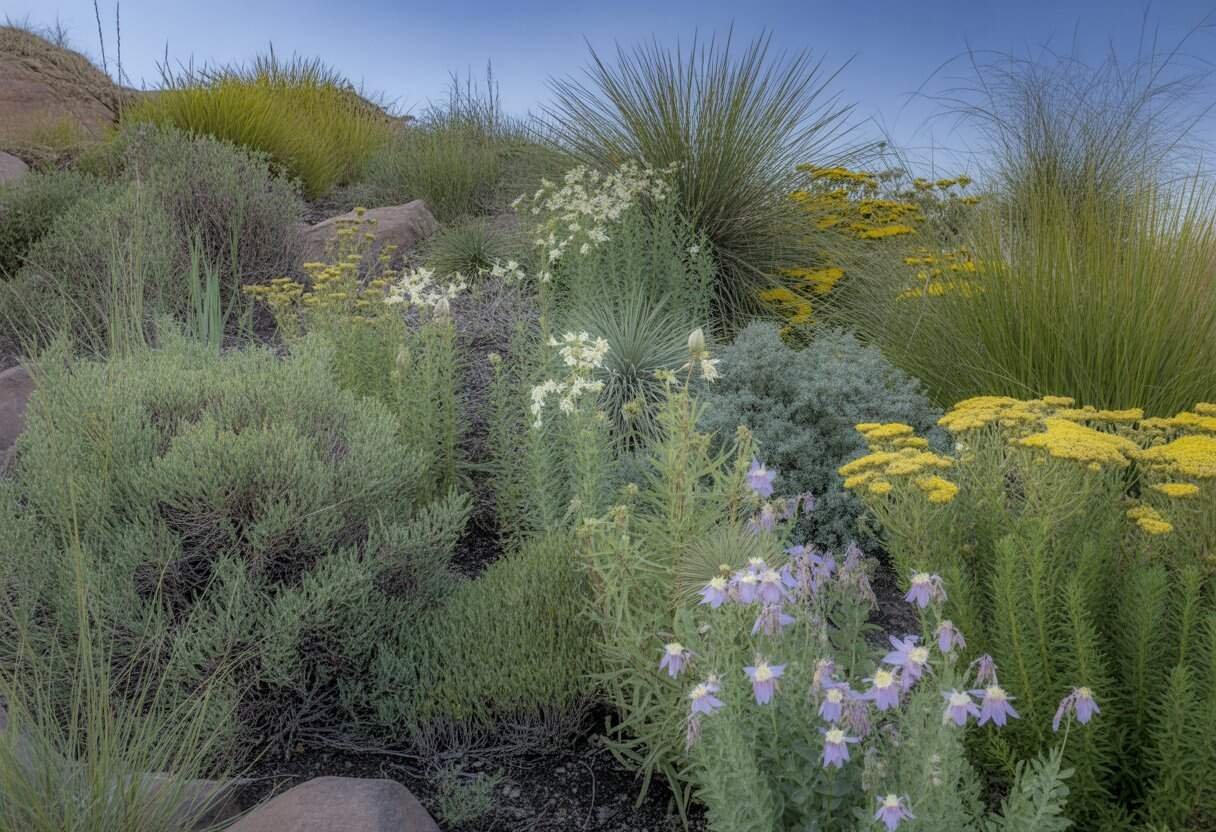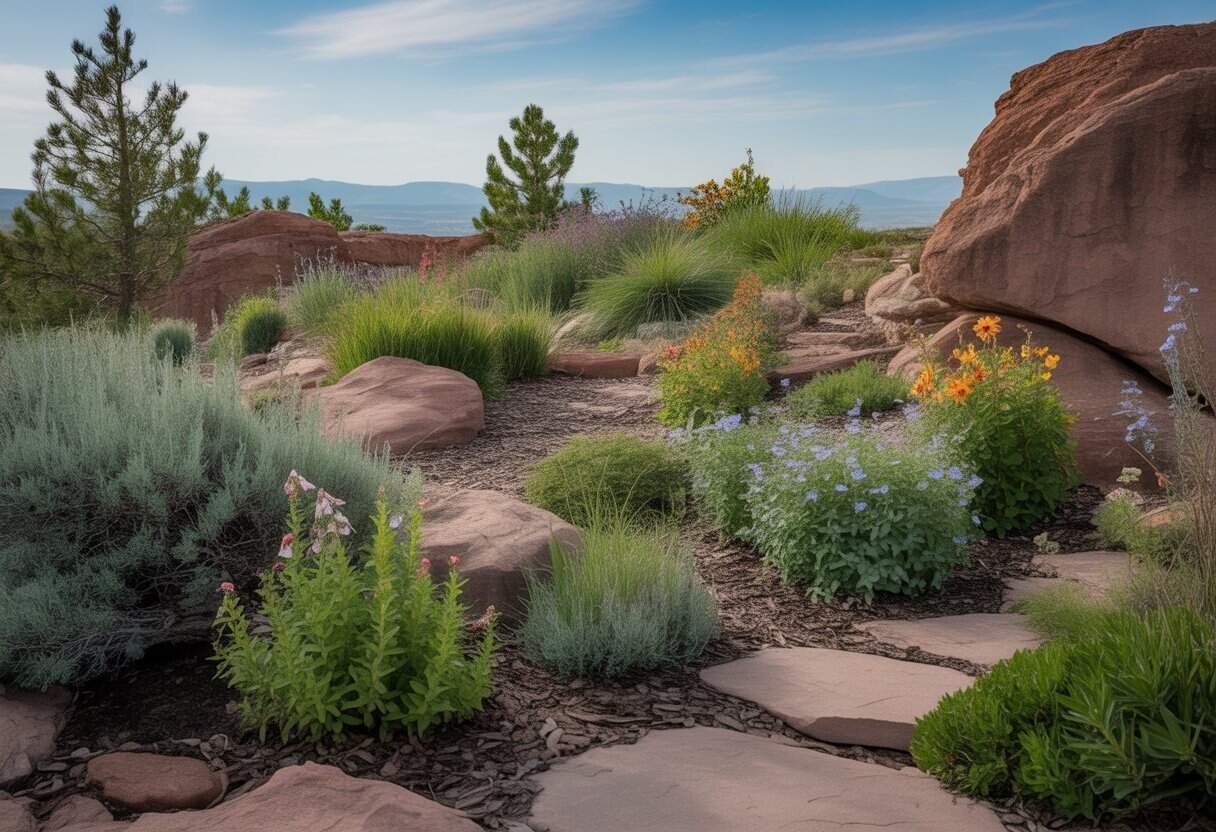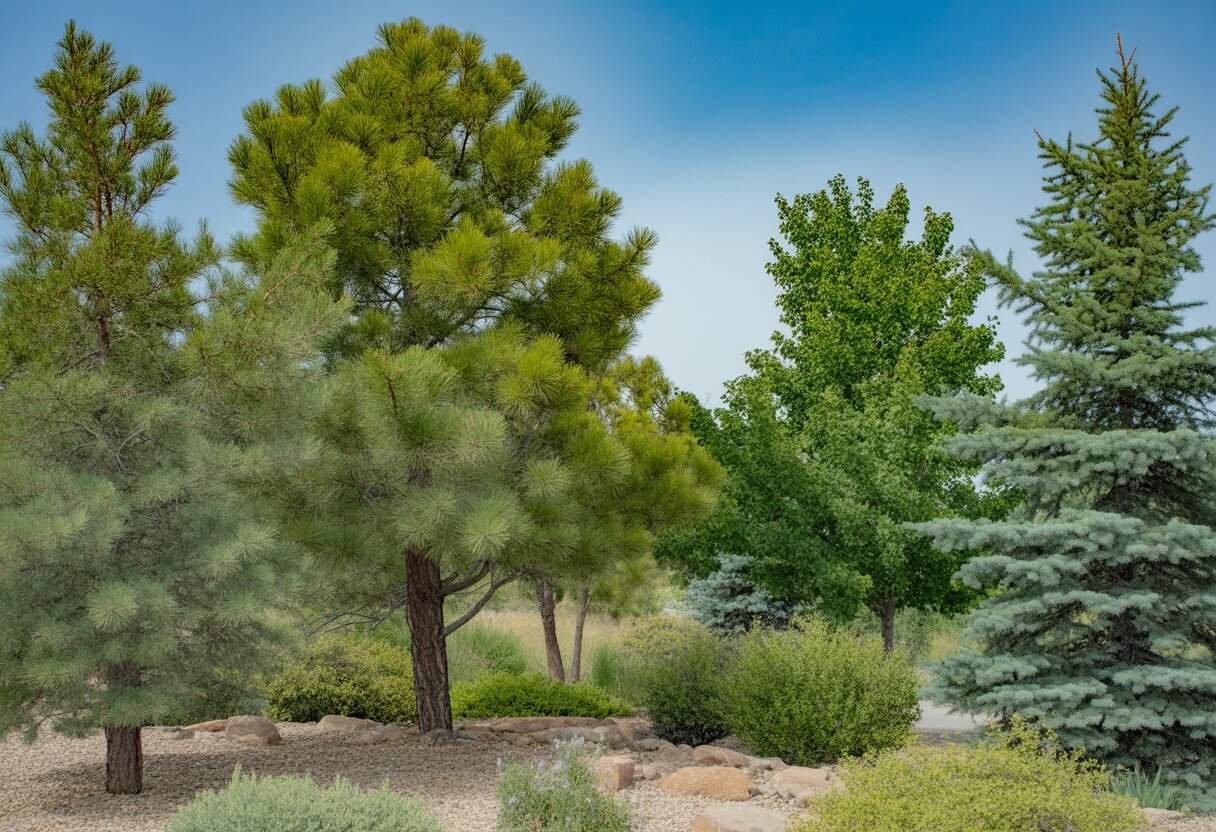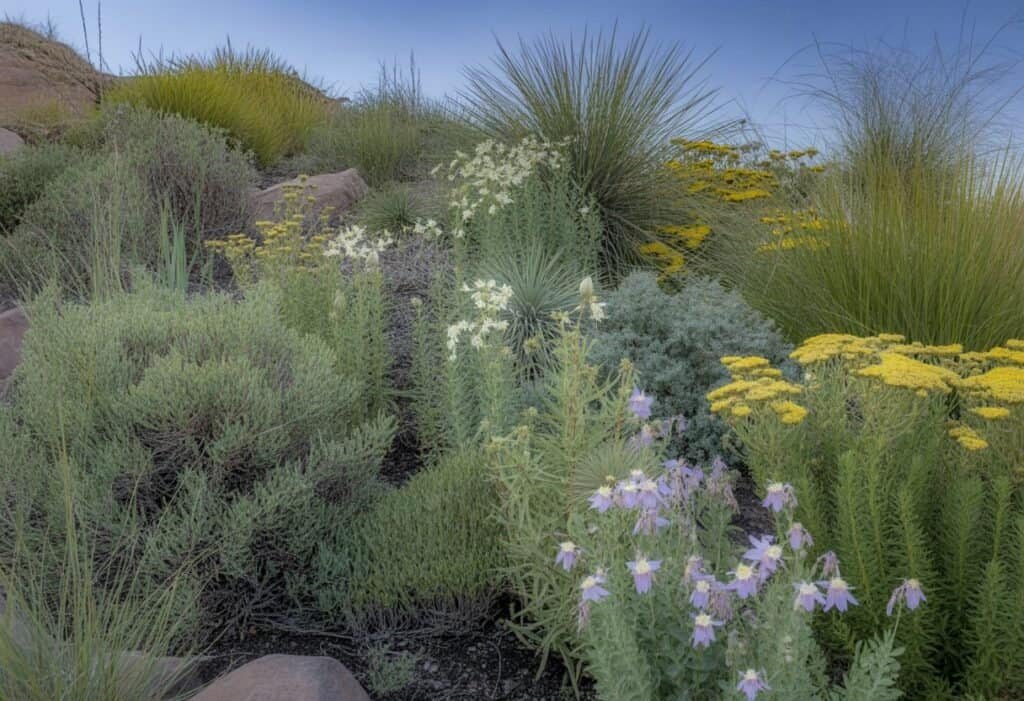Colorado’s native plants offer beauty and benefits to any home landscape. These plants have evolved to thrive in our unique climate and need less water and maintenance than non-native species.
Using native Colorado plants in your landscaping saves time, money, and resources. They also create a vibrant ecosystem for local wildlife.

From colorful columbines to sturdy ponderosa pines, Colorado’s diverse plant palette provides options for every yard. Native plants handle our challenging conditions naturally and withstand drought, survive temperature swings, and resist local pests without chemicals.
They connect your garden to Colorado’s natural heritage. Native plants bring seasonal interest throughout the year.
Key Takeaways
- Native Colorado plants require less water, fertilizer, and maintenance than non-native alternatives.
- Using native species supports local wildlife, including birds, butterflies, and beneficial insects.
- Colorado natives like blue spruce, serviceberry, and prairie grasses provide year-round visual interest while thriving in local conditions.
Benefits of Using Native Colorado Plants in Landscaping
Native Colorado plants offer significant advantages for homeowners and landscape designers. These plants have evolved in our unique climate and provide natural solutions to many common landscaping challenges.
Sustainable Landscape Practices
Native plants form the foundation of sustainable Colorado landscapes. They have adapted to local soil conditions over thousands of years, so you don’t need to add soil amendments or fertilizers.
Their deep root systems prevent erosion on slopes. They also help manage stormwater runoff.
Native plants support sustainable water cycles. Their roots reach deep into the soil, accessing moisture that non-native species can’t reach.
This reduces the need for irrigation systems. You can save water and money by using native plants.
Native plants can withstand Colorado’s temperature extremes, from hot summers to freezing winters. They bounce back from weather events that might damage or kill non-native species.
Wildlife Habitat and Biodiversity
Native plants provide essential food and shelter for local wildlife. Colorado’s native flowers, shrubs, and trees produce berries, seeds, and nectar that support birds, butterflies, and beneficial insects.
Wildlife habitat creation happens naturally with native plantings. For example:
- Blanketflower and Penstemons: Attract hummingbirds and butterflies
- Rocky Mountain Juniper: Provides winter shelter and berries for birds
- Buffalo Grass: Creates habitat for ground-nesting birds and small mammals
A yard with diverse native plants supports complex food webs and ecological relationships. Native landscapes increase biodiversity compared to traditional lawns.
Pollinators especially benefit from native plant gardens. Many Colorado wildflowers have co-evolved with native bee species, creating beneficial relationships that help maintain healthy ecosystems.
Reduced Maintenance and Water Use
Native plants significantly decrease landscape maintenance requirements. Once established, they typically need little to no supplemental water beyond natural rainfall.
This water efficiency can reduce irrigation costs and conserve Colorado’s precious water resources. Maintenance time drops considerably with native landscapes.
These plants generally:
- Require no fertilizer
- Need minimal or no pesticides
- Thrive without frequent pruning
- Eliminate or reduce mowing needs
Native plants resist local pests and diseases because they’ve developed natural defenses. This means fewer chemical treatments and less time spent on plant problems.
Native plants also adapt to Colorado’s challenging soil conditions, including clay, sand, or alkaline soils. Non-native species often struggle or fail in these conditions.
Essential Considerations for Colorado Landscape Design

When planning a Colorado landscape, you need to understand the local environment and support wildlife. Reflecting regional character leads to successful, sustainable gardens.
Colorado Climate and Soil Factors
Colorado’s unique climate presents specific challenges for landscape design. Most regions receive low annual rainfall (14-18 inches) and experience wide temperature swings.
The growing season varies from 120 days in mountain areas to 180 days along the Front Range. Soil conditions across Colorado typically include alkaline pH levels (7.5-8.0) and low organic matter.
Many areas have clay or sandy soils that require amendments. Before planting, homeowners should conduct a soil test through Colorado State University Extension to determine specific needs.
Colorado’s elevation impacts plant selection. For every 1,000 feet of elevation gain, temperatures drop about 3.5°F.
This means plants that thrive in Denver may struggle in mountain communities like Estes Park or Breckenridge.
Climate considerations:
- Winter hardiness zones: 4-7 (varies by location)
- Drought tolerance essential
- Wind resistance important for exposed sites
- Microclimates vary within properties
Supporting Beneficial Insects
Native plant landscapes create crucial habitat for Colorado’s beneficial insects. Pollinators like native bees, butterflies, and moths rely on specific plant relationships.
Including flowering plants with overlapping bloom times ensures season-long food sources. Early spring bloomers like pasqueflower and golden currant support insects emerging from winter dormancy.
Late-season plants like rabbitbrush and sunflowers provide critical fall resources. Beneficial predatory insects such as ladybugs and lacewings help control garden pests naturally.
These insects thrive when you include tall grasses, woody shrubs, and perennial flowers of varying heights.
To maximize insect benefits:
- Avoid pesticide use
- Include water sources (bird baths, shallow dishes)
- Provide overwintering habitat with unmowed areas
- Plant in groups of 3-5 of the same species
Promoting Community and Regional Identity
Thoughtful landscape design connects properties to Colorado’s natural heritage. Native plantings reflect regional character and create visual continuity throughout neighborhoods.
Using plants from local ecosystems helps landscapes feel authentic. A Denver yard with shortgrass prairie species or a mountain property with subalpine plants tells a story about place and belonging.
Native landscapes educate visitors and neighbors about Colorado’s botanical heritage. Plant identification markers or small educational signs can highlight interesting species and their traditional uses by indigenous peoples.
Community benefits include:
- Lower water usage benefiting municipal systems
- Reduced maintenance noise and pollution
- Increased property values (15-20% with native landscaping)
- Strengthened sense of regional pride
Native plant gardens also inspire neighbors to consider similar approaches. This creates a ripple effect of sustainable practices throughout communities.
Popular Colorado Native Trees for Landscaping

Colorado’s native trees are perfectly adapted to the state’s challenging climate and soil conditions. They offer beautiful landscaping options while supporting local wildlife and conserving water.
Ponderosa Pine and Bristlecone Pine
Ponderosa Pine (Pinus ponderosa) stands as a majestic choice for larger properties. This drought-tolerant evergreen grows 60-100 feet tall with orange-brown bark that smells like vanilla when warm.
Ponderosa pines provide year-round screening and windbreak benefits. They thrive in full sun and well-drained soils and need minimal water once established.
Bristlecone Pine (Pinus aristata) offers dramatic character to landscapes with its twisted, gnarled growth habit. These slow-growing trees reach 30-40 feet in height and can live for thousands of years.
Bristlecones excel in rocky, harsh conditions where other trees struggle. Their distinctive appearance makes them ideal focal points in xeriscape gardens.
They need excellent drainage and resist both drought and cold extremely well.
Colorado Blue Spruce and Douglas Fir
Colorado Blue Spruce (Picea pungens) serves as Colorado’s state tree and a popular landscape choice. Its silvery-blue needles create striking color contrast in gardens, and it grows 30-60 feet tall.
Blue spruces prefer moist, well-drained soil but adapt to various conditions once established. They withstand heavy snow loads and provide excellent wildlife habitat.
Douglas Fir (Pseudotsuga menziesii) isn’t a true fir but offers similar benefits. This evergreen reaches 40-80 feet tall with soft, dark green needles and cones with mouse-tail bracts.
Douglas firs grow faster than many native conifers and tolerate partial shade. They provide excellent windbreaks and screening while supporting many bird species.
These trees prefer moderate moisture and some protection from harsh winter winds.
Cottonwoods and Quaking Aspen
Narrowleaf Cottonwood (Populus angustifolia) and Plains Cottonwood (Populus deltoides) thrive along waterways. These fast-growing trees reach 50-70 feet tall and provide quick shade.
Cottonwoods need regular water and work best in larger properties away from structures due to their extensive root systems. Their yellow fall color brightens autumn landscapes.
Quaking Aspen (Populus tremuloides) creates stunning visual impact with its bright white bark and golden fall color. The trembling leaves move in the slightest breeze.
Aspens naturally grow in colonies through root suckers, creating beautiful groves. They prefer cooler, moister sites and higher elevations.
For best results, plant aspens in groups where they have room to spread, ideally on north or east-facing slopes.
Smaller Trees: Gambel Oak, Three-Leaf Sumac, and Chokecherry
Gambel Oak (Quercus gambelii) grows as a multi-stemmed small tree reaching 15-30 feet. It forms thickets that provide excellent wildlife habitat and shows attractive lobed leaves that turn russet-brown in fall.
This drought-tolerant oak adapts to poor soils and creates natural privacy screens. It’s perfect for naturalized areas and needs minimal maintenance.
Three-Leaf Sumac (Rhus trilobata) works as either a large shrub or small tree. Its glossy green leaves turn brilliant red-orange in fall, followed by fuzzy red berries that last through winter.
Sumac thrives in poor soil and drought. It works well in masses for erosion control on slopes.
Chokecherry (Prunus virginiana) provides multiple seasons of interest with fragrant white spring flowers, dark purple fruits, and golden fall color. Growing 15-25 feet tall, it attracts birds and pollinators.
Chokecherries adapt to various soil types and moisture levels. The fruits make excellent jellies and syrups but should be cooked before eating.
Shrubs Native to Colorado and Their Landscape Uses
Colorado’s native shrubs offer beauty, drought tolerance, and wildlife habitat while requiring minimal maintenance in home landscapes. These hardy plants have adapted to our unique climate and soil conditions over thousands of years.
Mountain Mahogany and Rabbitbrush
Mountain Mahogany (Cercocarpus montanus) grows 4-6 feet tall with silvery-green leaves and feathery seedheads in fall. This shrub thrives in rocky, poor soils and resists drought.
Its deep root system prevents erosion on slopes. Its dense growth makes it excellent for natural privacy screens.
Rabbitbrush (Chrysothamnus nauseosus) displays bright yellow flowers in late summer when few other plants bloom. Growing 2-4 feet tall, it attracts butterflies and provides late-season nectar.
Both shrubs need minimal water once established. They perform best in full sun with well-draining soil.
Neither needs pruning except to remove dead branches. This makes them low-maintenance landscape options.
Wax Currant and Western Sand Cherry
Wax Currant (Ribes cereum) features small pink flowers in spring followed by edible red berries that attract birds. This compact shrub (3-5 feet tall) tolerates partial shade, making it versatile for woodland gardens or under trees.
Western Sand Cherry (Prunus besseyi) produces fragrant white flowers in early spring before leafing out. Its dark purple fruits make excellent jams and attract wildlife.
Key landscape uses:
- Foundation plantings near buildings
- Mixed shrub borders
- Wildlife gardens
- Erosion control on slopes
Both shrubs benefit from mulching to retain moisture and suppress weeds. They require little supplemental water after establishment and resist most common pests and diseases.
Hoptree and Western Water Birch
Hoptree (Ptelea trifoliata) grows as a large shrub or small tree, reaching 8-15 feet tall. Its circular winged seeds resemble hops, and glossy green leaves turn golden yellow in fall.
Hoptree adapts to both dry and moist conditions. You can use it in various garden settings.
Western Water Birch (Betula occidentalis) thrives near water sources. Its red-brown bark and diamond-shaped leaves stand out in the landscape.
This shrub prefers consistent moisture. Plant Western Water Birch near downspouts, in rain gardens, or in naturally moist areas.
Its multi-stemmed form creates year-round visual interest. Both shrubs support local wildlife and add vertical structure to gardens.
They blend well with native perennials and grasses. This creates a cohesive Colorado landscape.
Incorporating Native Herbaceous Perennials and Wildflowers
Native perennials and wildflowers add color and texture to Colorado landscapes. They use less water than non-native options.
These plants support local pollinators. They help create sustainable gardens that thrive in Colorado’s climate.
Gaillardia and Prairie Coneflower
Gaillardia, or blanket flower, brings vibrant reds and yellows to gardens from June through September. This perennial grows 12-24 inches tall and attracts butterflies and bees.
Plant gaillardia in full sun with well-drained soil. Once established, it needs minimal water and care.
Prairie coneflower (Ratibida columnifera) has drooping yellow petals and a prominent center cone. This native thrives in dry, sunny locations and blooms all summer.
Benefits of these native flowers:
- Drought resistance after establishment
- Long blooming period (3-4 months)
- Excellent pollinator attraction
- Self-seeding capabilities
- Winter interest from seed heads
These plants work well in xeriscapes, meadow gardens, and borders. Pair them with ornamental grasses and other prairie natives.
Penstemon Varieties
Colorado features many native penstemon species, also called beardtongue. These perennials produce tubular flowers in blue, purple, red, and white.
Rocky Mountain penstemon (Penstemon strictus) grows 2-3 feet tall with blue-purple blooms. It adapts to different soils and attracts hummingbirds and native bees.
Sidebells penstemon (Penstemon secundiflorus) has pink to lavender flowers along one side of the stem. This shorter variety (12-18 inches) fits well in rock gardens.
For successful penstemon growth:
- Plant in full sun to light shade.
- Ensure excellent drainage.
- Water sparingly after establishment.
- Avoid fertilizing; they prefer lean soil.
Combine penstemons with other drought-tolerant natives like blue grama grass and prairie sage. Their vertical flower spikes add architectural interest.
Using Colorado Native Grasses in Landscaping
Native Colorado grasses offer beauty, drought resistance, and wildlife habitat. They need less water and maintenance than traditional turf grasses.
These grasses provide year-round visual interest. They fit well in residential landscapes.
Buffalo Grass and Big Bluestem
Buffalo grass grows 4-8 inches tall and forms a dense, blue-green turf. It needs only a quarter the water of Kentucky bluegrass.
Buffalo grass is dioecious, with separate male and female plants. Female plants produce seed heads that add texture to gardens.
Big bluestem reaches 4-6 feet tall with three-part seed heads that look like turkey feet. Its blue-green summer foliage turns copper-red in fall.
Big bluestem develops deep roots, up to 12 feet, which improve soil structure and prevent erosion. Plant it in masses for privacy screens or dramatic backdrops.
Western Wheatgrass, Arizona Fescue, and June Grass
Western wheatgrass forms blue-green stands 1-3 feet tall with attractive seed heads. This grass spreads slowly by rhizomes, creating drought-resistant meadows.
Its blue color comes from a waxy leaf coating. Western wheatgrass thrives in clay soils.
Arizona fescue forms neat clumps 1-2 feet tall with fine, blue-green foliage. This bunch grass keeps its color through winter.
June grass creates airy seed heads on 1-2 foot stems. It blooms in May and June and fits well in rock gardens or borders.
Its small size suits residential landscapes. June grass adds texture and movement.
Indian Rice Grass and Switchgrass
Indian rice grass grows in fountain-like clumps with delicate, airy seed heads. This 1-2 foot tall bunch grass does well in sandy, well-drained soils.
Native Americans once harvested its seeds for food. In gardens, Indian rice grass adds a soft, textural element that pairs well with wildflowers.
Switchgrass forms upright clumps 3-5 feet tall with reddish seed heads. Its blue-green summer foliage turns gold in fall and stands through winter.
This grass tolerates a wide range of soil conditions, from dry to occasionally wet. Plant switchgrass in groups of 3-5 for strong visual impact.
Its vertical form creates effective privacy screens. Mass plantings provide the best effect.
Best Practices for Creating a Thriving Native Colorado Landscape
Creating a native plant landscape takes thoughtful planning and good techniques. Native plants thrive when placed in conditions similar to their natural habitats.
Plant Selection and Grouping
Choose plants native to your specific Colorado region. Front Range plants differ from mountain species, and southern Colorado plants may not suit northern areas.
Research each plant’s natural habitat. Group plants with similar water needs together; this method is called hydrozoning.
Hydrozoning prevents overwatering drought-tolerant plants or underwatering those that need more moisture. Consider mature plant sizes, as native shrubs and perennials often grow larger in gardens.
Plant in odd-numbered groups like 3, 5, or 7 for a natural look and stronger visual impact. Match plants to your yard’s microclimates.
South-facing areas suit prairie plants. North-facing spots work better for woodland species.
Seasonal Interest and Year-Round Appeal
Design your landscape for interest in every season. Include early bloomers like pasqueflower and golden banner for spring color.
Add summer-flowering perennials such as Rocky Mountain penstemon and blanketflower for summer color. Choose plants that provide fall and winter interest.
Rabbitbrush offers golden blooms in autumn. Ornamental grasses add texture and movement in winter.
Include evergreen shrubs like juniper and piñon pine to anchor the landscape. Select plants with interesting seed heads or berries for wildlife and winter appeal.
Encouraging Adaptation and Resilience
Water new native plants regularly during their first two growing seasons. This helps them develop deep root systems for drought resistance.
Apply 2-3 inches of mulch around plants, but keep it away from stems. Use wood chips or gravel mulch to conserve moisture and suppress weeds.
Avoid heavy fertilizing. Native plants usually perform best in lean soils.
Let some natural dieback occur in winter. Dead stems and seed heads provide wildlife habitat and winter interest.
Watch for invasive species and remove them early. This prevents them from taking over your native garden.
Frequently Asked Questions
Colorado gardeners often have questions about native plants. These plants offer water savings, support wildlife, and adapt well to local conditions.
What are the best native plants to use for landscaping in Colorado’s full sun exposure?
Colorado’s sunny areas support many beautiful natives. Blue grama grass creates a low-maintenance lawn alternative and thrives in full sun.
Prairie zinnia offers bright yellow flowers all summer with minimal water. The plant grows in small, spreading mounds.
Sulphur flower (Eriogonum umbellatum) produces vibrant yellow blooms on drought-tolerant foliage. It attracts butterflies and needs little maintenance once established.
Rocky Mountain penstemon adds blue-purple flowers to sunny gardens. This perennial reaches about 2 feet tall and handles intense sun well.
Which low maintenance native plants are recommended for Colorado landscapes?
Pasque flower grows 6-8 inches tall and produces purple blooms in early spring. It needs little care once established in well-draining soil.
Rabbitbrush thrives in poor soils and requires no extra water after establishment. Its yellow fall flowers provide late-season nectar for pollinators.
Little bluestem grass forms blue-green clumps that turn reddish-copper in fall. Cut it back only occasionally in late winter.
Prairie sage creates silvery foliage that looks good year-round. This aromatic plant deters deer and needs only occasional trimming.
What are some top choices of native flowers that thrive in Colorado’s climate?
Blanketflower produces red and yellow daisy-like blooms from early summer to frost. This hardy plant reseeds easily and attracts pollinators.
Rocky Mountain columbine, Colorado’s state flower, features blue and white blooms. It grows best with afternoon shade but tolerates various conditions.
Golden banner creates bright yellow flowers in spring. This legume spreads slowly and improves soil quality.
Chocolate flower has cocoa-scented yellow blooms that open in the morning and close by afternoon. The flowers repeat throughout summer.
Where can one find and purchase Colorado-native plants suitable for landscaping?
Front Range Wild Ones hosts native plant sales each spring at various locations. Their website lists upcoming events and available plants.
High Country Gardens specializes in western native plants and ships throughout Colorado. Their catalog provides detailed growing information.
Local nurseries like Harlequin’s Gardens in Boulder and Tagawa Gardens stock native plants. These businesses offer expert advice on selection and care.
The Colorado Native Plant Society keeps a list of reliable native plant nurseries. Their website connects gardeners with specialty growers.
What are the native flora of the Colorado Front Range that can be used in home gardens?
Kinnikinnick is an excellent native groundcover with evergreen leaves and red berries. This plant thrives in partly shady Front Range areas.
Wild geranium produces pink flowers in spring and attractive seed heads later. It grows naturally in the foothills and adapts well to gardens.
Boulder raspberry forms a thornless shrub with white flowers and edible fruit. This native raspberry grows 3-4 feet tall and spreads slowly.
Chokecherry trees provide spring flowers, summer berries, and fall color. Birds enjoy the fruits, making this tree valuable for wildlife gardens.
How can one ensure the successful cultivation of Colorado-native plants in their yard?
Group plants with similar water needs together. This prevents overwatering.
Most natives need regular water during establishment. Afterward, they require very little water.
Avoid fertilizing native plants in most cases. These plants evolved in Colorado’s lean soils and often do better without added nutrients.
Mulch with local materials like pine needles or shredded leaves. These mulches break down slowly and create conditions similar to natural ecosystems.
Allow some natural seed production to encourage self-sustaining plant communities. Many natives will establish balanced populations if given the chance.


